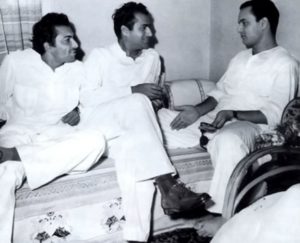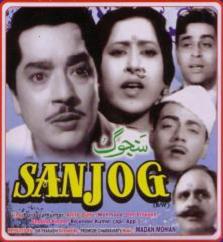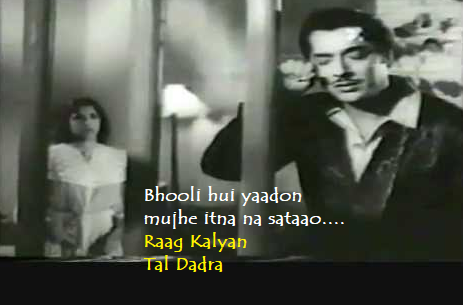Raaga Based Song of the Day: Bhooli hui yaadon mujhe itna na sataao….
Raag Kalyan, Tal Dadra
Yesterday, I brought out that I hadn’t even given you a proper (melodic) song in this favourite raag of beginners in Indian Classical Music as well as favourite with Hindi films music directors. I had brought out that I had given you a song in Raag Kalyan earlier on the 14th day (Lagta nahin ahai dil mera ujade dayaar mein) (Please see: ‘Raaga Based Song Of The Day #14‘). However, the entire song was in Alaap and hence didn’t have a Tal. Of course, I missed telliing you about having given you a song in Raag Shuddha Kalyan (Tal Kaherava): Rasik balma; being my #1 favourite of Lata Mangeshkar (Please see: ‘Raaga Based Song Of The Day #33‘). Hence, with yesterday’s song in Shyam Kalyan, we have had three songs in Raag Kalyan and its variations so far: Lagta nahin hai dil mera (Alaap), Rasik Balma (Tal Kaherava) and Youn neend se vo jaan-e-chaman (Tal Dadra).
Today lets make up for not having given you a song in Raag Kalyan, the basic raag of Kalyan Thaat. It is in Tal Dadra.

Despite the fact that Madan Mohan‘s first recorded song, in the 1950 movie Aankhen, was sung by Mukesh: Preet lagake maine, Madan Mohan and Mukesh, in 25 years, recorded only nine songs together and were together in just five movies: Aankhen (1950), Samundar (1957), Duniya Na Mane (1959), Sanjog (1961), and Akeli Mat Jaiyo (1963). In Sanjog, Madan Mohan gave Mukesh one of the finest song that the latter is rememberd by and I am giving you that today.
We have completed sixty-two days of Raaga Based Songs of the Day. Our first post in the series was titled ‘Raaga Based Song Of The Day #1’ and the song was a Mohammad Rafi and Lata Mangeshkar song from the 1970 Shakti Samanta movie Pagla Kahin Ka: Tum mujhe youn bhula na paoge. It is in Raag Jhinjhoti, Tal Kaherava.
Our sixty-second post or the last post was titled ‘Raaga Based Song Of The Day #62‘ and the song was a Kishore Kumar song from the 1978 Sunil Dutt movie Dard Ka Rishta starring Sunil Dutt, Smita Patil, Reena Roy and Ashok Kumar: Youn neend se vo jaan-e-chaman jaag uthi hai. It is in Shyam Kalyan, Tal Dadra.
This blog has a number of posts on Raaga based songs in Hindi movies titled similarly; for example: ‘The Best Raaga Based Songs in Hindi Movies – Raaga Bhimpalasi – Part II‘.
In the last sixty-two days of sharing Raaga based songs of the day, I have given you songs based on Raag Jhinjhoti, Gara, Bhimpalasi, Madhuvanti, Shivaranjani, Bihag, Pahadi, Sarang, Pilu, Bhairavi, Khammaj, Charukesi, Kalyan or Yaman, Desh, Malgunji, Kirwani, Kedar, Bageshri, Megh Malhar, Bhupali, Ahir Bhairav, Malkaush, Mand, Adana, Kafi, Rageshri, Jaunpuri, Tilang, Janasammohini, Chayanat, Shuddha Kalyan, Gaur Sarang, Jogiya, Asavari, Maru Bihag, Durga, Lalit, Puria Dhanashri, Bhinna Sahdja, Sohani, Multani, Patdeep, Jaijaiwanti, Tilak Kamod, Hemant, Basant Mukhari, Gujri Todi, Kalavati, Hamir, Bhatiyar, Gawati and Shyam Kalyan. The only five raagas that have been repeated so far are Pahadi, the raaga of my home place in the Himalayas, Maru Bihag, Raag Kirwani, Jhinjhoti and Bhairavi. That makes a total of 52 raagas so far. Today, I am giving you a song in a new raag Kalyan. It appears to be repeat; however, last time I had given the song in Alaap only.
Today, I give you a song sung by Mukesh on the lyrics of Rajendra Krishan and on a composition by Madan Mohan. As I said, it is in Raag Kalyan, Tal Dadra.
However, first, lets take up the value added learning of today. Today, we shall learn about Natya Shastra since I have referred to this ancient treatise a number of times.
Natya Shastra, written in Sanskrit by the sage Bharat Muni, in the years 200 BC to 200 CE, is the oldest surviving document on performing arts in the world. The word ‘surviving’ is used to convey the fact that Natya Shastra was based on a still older document called Natya Sutra but the latter didn’t survive.
Music is just one of the wide range of topics discussed in Natya Shastra. There are 36 chapters containing 6000 poetic verses describing performance arts. The subjects covered by include dramatic composition, structure of a play and the construction of a stage to host it, genres of acting, body movements, make up and costumes, role and goals of an art director, the musical scales, musical instruments and the integration of music with art performance. There is, as far as music is concerned, a detailed analysis of musical scales and movements (murchhanas). As far as dance is concerned, there is an analysis of dance forms that considers several categories of body movements and their effect on the viewer. The ‘‘Natya Shastra’’ posits that drama originated because of the conflicts that arose in society when the world declined from the Golden Age (Kŗta Yuga) of harmony, and therefore a drama always represents a conflict and its resolution.
Bharata’s theory of drama refers to bhavas, the imitations of emotions that the actors perform, and the rasas (emotional responses) that they inspire in the audience. The eight basic bhavas (emotions) are: love, humor, energy, anger, fear, grief, disgust and astonishment. In observing and imagining these emotions, the audience experiences eight principal responses, or rasas: love, pity, anger, disgust, heroism, awe, terror and comedy. The text contains a set of precepts on the writing and performance of dance, music and theater, and while it primarily deals with stagecraft, it has influenced Indian music, dance, sculpture, painting and literature as well. Thus, the Natya Shastra is considered the foundation of the fine arts in India.
After the Samaveda that dealt with ritual utterances of the Vedas, the ‘‘Natya Shastra’’ is the first major text that deals with music at length. It is considered the defining treatise of Indian Classical Music until the thirteenth century, when the stream bifurcated into Hindustani classical music in North India and Pakistan, and Carnatic classical music in South India.
While much of the discussion of music in the ‘‘Natya Shastra’’ focuses on musical instruments, it also emphasizes several theoretical aspects that remained fundamental to Indian music:
1. Establishment of Shadja as the first, defining note of the scale or grama. The word Shadja (षड्ज) means ‘giving birth to six’, and refers to the fact that once this note (often referred to as “sa” and notated S) is fixed, the placement of other notes in the scale is determined.
2. Principle of Consonance: Consists of two principles:
a. The first principle states that there exists a fundamental note in the musical scale which is Avinashi (अविनाशी) and Avilopi (अविलोपी) that is, the note is ever-present and unchanging.
b. The second principle, often treated as law, states that there exists a natural consonance between notes; the best between Shadja and Tar Shadja, the next best between Shadja and Pancham.
3. The ‘‘Natya Shastra’’ also suggest the notion of musical modes or jatis, which are the origin of the concept of the modern melodic structures known as ragas. Their role in invoking emotions is emphasized; compositions emphasizing the notes gandhara or rishabha are said to be related to tragedy (karuna rasa), and rishabha is to be emphasized for evoking heroism (vira rasa). Jatis are elaborated in greater detail in the text Dattilam, composed around the same time as the ‘‘Natya Shastra.’’
As I mentioned, today’s song is composed in Raag Kalyan, Tal Dadra.
Raag Kalyan is the basic raaga of Kalyan Thaat. Its Jati is Sampurna-Sampurna, that is, all seven notes in Aaroha and all seven notes in Avaroha. All the scale notes (called swaras) in the raga are Shuddha, the exception being Teevra Madhyam or prati madhyamam. It is sung during the first prahar of the night, that is, between 6 to 9 PM. Raag Kalyan of Hindustani Music is also known as Raag Yaman in Carnatic Music; however, Raag Yaman Kalyan is a totally different raag. Considered to be one of the most fundamental ragas in the Hindustani Classical tradition, it is thus often one of the first ragas taught to students.
Some of the Hindi films songs composed in raag Shyam Kalyan are:
| 1. 2. 3. 4. 5. 6. 7. 8. 9. 10. 11. 12. 13. 14. 15. 16. 17. 18. 19. 20. 21. 22. 23. 24. 25. 26. 27. 28. 29. 30. 31. 32. 33. 34. 35. 36. 37. 38. 39. |
Khuda Nigahbaan Ho Main Kya Jaanu Kya Aansoo Bhari Hai Man Re Tu Ang Ang Rang Re Man Sur Mein Ga Aapke Anorodh Par Is Mod Se Jate Jo Tum Todo Piya Hamari Thodi Si Bewafai Aaj Hum Apni Nav Kalpana Nav Roop Na Jao Saeeyan Mithe Bol Bole Mitwa Bole Meethe Jane Kya Sochkar Tarana Mohe Maro Na Kanha Dekho Ri Koi Ehsaan Tera Hoga Chale Ja Rahe Hain Yahi Hai Tamanna Gahar Se Nikalte Saras Raat Man Bhaye Salaam-e-Hasrat Kabhi Kabhi Mere Dil Mein Nigahein Milane Ko Paan Khayo Saiyan Hamaro Sabere Ka Suraj Tera Chhehera Woh Shaam Kuchh Maangne Se Jo Maut Mausam Hai Aashiqana Sapna ban Saajan Chhupalo Yun Dil Woh Jab Yaad Aaye Jhamela Jhoote Jag Ka Diya Jalao Jagmag Nukta Chi Hain |
Mughal-E-Azam Zindagi Parvarish Chitralekha Sandhya Lal Pathar Anurodh Aandhi Meera Thodi Si Bewafai Pakeezah Mrigtrishna Sahib Bibi Aur Ghulam Kinara Parichaye Kinara Pakeezah Manavta Ganga Ki Leherein Junglee Kinare Kinare Aapki Parchhaiyan Papa Kehte Hain Suwarn Sundari Babar Kabhi Kabhi Dil Hi To Hai Teesri Kasam Ek Baar Muskura Do Aapas Ki Baat Khamoshi Sunehere Kadam Pakeezah Shokhiyan Mamta Parasmani Bhajan Tansen Mirza Galib |
Lata K L Saigal Mukesh Rafi Sulakshana Asha, Manna Dey Kishore Lata, Kishore Vani Jayram Kishore, Lata Lata Rafi Geeta Dutt Bhupendra, Lata Bhupendra Kishore Lata Lata Asha Rafi Manna Dey Rafi Udit Narayan Rafi, Lata Sudha Malhotra Mukesh, Lata Asha Asha Kishore Kishore Kishore Lata Lata Lata Lata, Hemant Lata, Rafi Mukesh K L Saigal Suraiya |

The song Bhooli hui yaadon mujhe itna na sataao is from the 1961 Pramod Chakravorty movie Sanjog that starred Pradeep Kumar and Anita Guha.
The song was penned by Rajendra Krishan and composed by Madan Mohan (Kohli). It was sung by Mukesh, one of the nine of Madan Mohan songs that he sang in 25 years.
Please enjoy in Raag Kalyan, Tal Dadra: Bhooli hui yaadon mujhe itna na sataao….
Bhuulii huii yaado.n, mujhe itanaa naa sataao
Ab chain se rahane do, mere paas na aao
Bhuulii huii yaado.n …
Daaman me.n liye baiThaa huu.N, (TuuTe hue taare – 2)
Kab tak mai.n jiyuu.Ngaa yuu.Nhii, (khvaabo.n ke sahaare – 2)
DIvaanaa huu.N, ab aur naa dIvaanaa banaao
Ab chain se rahane do, mere paas na aao
Bhuulii huii yaado.n …
LUTo naa mujhe is tarah, (doraahe pe laake -2 )
Aavaaz na do ek (nayI raah dikhaake – 2)
Sa.nbhalaa huu.N mai.n gir-girake mujhe, phir naa giraao
Ab chain se rahane do mere paas naa aao
Bhuulii huii yaado.n, mujhe itanaa naa sataao
Ab chain se rahane do, mere paas na aao
Bhuulii huii yaado.n …
We have intended to learn about Raaga based music whilst we entertain ourselves with Raaga based songs. So, lets, once again, take stock of our collective learning so far:
- On the first day we learnt about the Raaga system devised by Pandit Vishnu Narayan Bhatkhande, which is the prevalent system in Hindustani Classical Music and based on ten Thaats.
- On the second day we learnt about Tal or Taal.
- On the third day we learnt about characteristics of Raagas that included Swar, Jati, Thaat, Arohana and Avarohana, Vadi, Samvadi and Pakad.
- On the fourth day, we learnt about Sargam.
- On the fifth day, we learnt about notations used in Indian classical music or simply Swar Lipi.
- On the sixth day, we learnt about the Ras (sentiments) that Raagas evoke.
- On the seventh day, we learnt about various types of Swar: Shuddha, Achal, Vikrut, Komal and Teevra.
- On the eighth day, we learnt the parts of a composition in Indian Classical Music.
- On the ninth day, we learnt the names of some of the popular instruments used in Indian Classical Music.
- On the tenth day, we learnt about the sources of names of Raagas.
- On the eleventh day, we learnt about why Bhairavi is the first raag to be taught to beginners and also why it is the last in a performance.
- On the twelfth day, we learnt about Khammaj Thaat.
- On the thirteenth day, we learnt about Tal Punjabi Theka or Sitarkhani.
- On the fourteenth day, we learnt about Alap.
- On the fifteenth day, we learnt about List of Raagas (Raagmala) in my favourite book: Sri Guru Granth Sahib.
- On the sixteenth day, we learnt about tips for raaga identification.
- On the seventeenth day, we learnt the basics of Gharana system.
- On the eighteenth day, we learnt about Filmi Sangeet.
- On the nineteenth day, we learnt about the commonest Tal in Raagas: Tintal.
- On the twentieth day, we learnt about the Kafi Thaat.
- On the twenty-first day, we learnt a little more in detail about the classification of Raagas.
- On the twenty-second day, we learnt the essential differences between Bhairavi and Bhairav.
- On the twenty-third day, we learnt a little more in detail about the Jati or Jaati of a raaga.
- On the twenty-fourth day, we learnt details of Thaat Bilawal, the most basic thaat in the Bhatkhande’s system of raagas.
- On the twenty-fifth day, we learnt about Tintal.
- On the twenty-sixth day, we learnt in detail about the Raaga – Samay linkage.
- On the twenty-seventh day, we learnt about Lehar.
- On the twenty-eighth day, we learnt about the history of the Hindustani Music.
- On the twenty-ninth day, we learnt about Dhrupad.
- On the thirtieth day, we learnt about Rupaktal that I was introduced to, a few months back, by my friend Anand Desai.
- On the thirty-first day, we learnt about Khayal.
- On the thirty-second day, we learnt about Thumri.
- On the thirty-third day, we learnt about Tappa.
- On the thirty-fourth day, we learnt about Tarana.
- On the thirty-fifth day, we learnt about Tal Dipchandi (Moghali).
- On the thirty-sixth day, we learnt about Tabla.
- On the thirty-seventh day, we learnt about Kirtan.
- On the thirty-eighth day, we learnt about Pakhawaj.
- On the thirty-ninth day, we learnt about Hori.
- On the fortieth day, we learnt about Dadra.
- On the forty-first day, we learnt about Kajri.
- On the forty-second day, we learnt about Chaiti.
- On the forty-third day, we learnt about Sarangi.
- On the forty-fourth day, we learnt about Shehnai.
- On the forty-fifth day, we learnt about Sarod.
- On the forty-sixth day, we learnt about Bansuri.
- On the forty-seventh day, we learnt about Ektal and Tanpura.
- On the forty-eighth day, we learnt about Veena.
- On the forty-ninth day, we repeated our learning of Veena with a small excitement added.
- On the fiftieth day, we learnt about Dilruba/Esraj.
- On the fifty-first day, we learnt about Jaltarang.
- On the fifty-second day we learnt about Qawwali.
- On the fifty-third day, we learnt about Sitar.
- On the fifty-fourth day, we learnt about Surbahar.
- On the fifty-fifth day, we learnt about Harmonium.
- On the fifty-sixth day, we learnt about Santoor.
- On the fifty-seventh day, we learnt about Swarmandal.
- On the fifty-eighth day, we learnt about the Shruti Box.
- On the fifty-ninth day, we learnt about Alankar.
- On the sixtieth day, we learnt about singing in Aakaar.
- On the sixty-first day, we learnt about the Classification of Indian Musical Instruments.
- On the sixty-second day, we learnt a little about Carnatic Music.
- And today, on the sixty-third day, we learnt about Natya Shastra.
There is much more still to be learnt and enjoyed.
Please stay tuned!

One of the important thing about these posts is that these are structured precisely and coherently . The post opens with a reference to previous day’s post and other posts in the series based on that raga . And then a brief account of current day’s song and raga followed by the list of ragas covered so far and then declaration of the song ,song writer , composer and the film. Then there is a break which sets us in the value added knowledge and similarily made to set out of it only to witness an introduction to the raga of the post and the list of songs composed in that raga . All these re-invigorate the readers’ interest and he is ready to enjoy the song that follows on down scroll . And finally before switching off a summary for revision of all that went in the past .
Thank you, Jaswant. Knowledge multiplies once it is shared. Whilst sharing, one has to imagine things not from one’s own point of view but how it would be assimilated by the reader. You are very perceptive and hence you have quickly perceived as to how these posts are structured to impart maximum benefit to the reader.